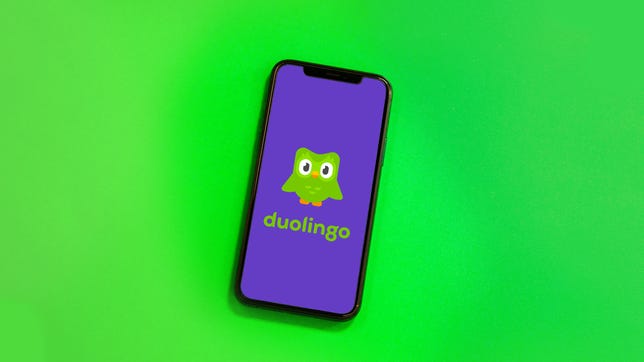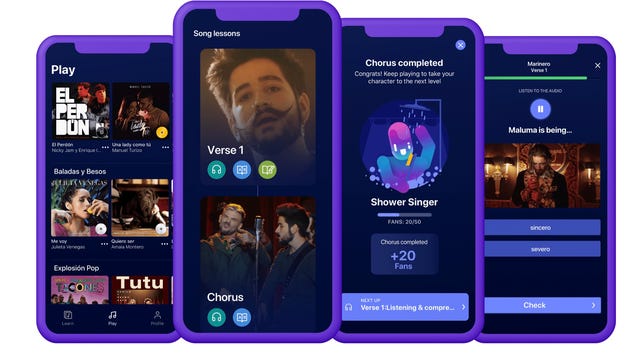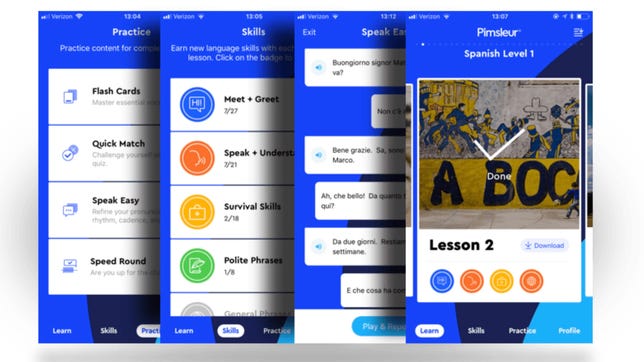Technologies
10 apps that can actually teach you a new language
The best language learning apps to learn a new language at home, no matter your style.

Learning a new language can be tough, but thankfully it’s also easier than ever thanks to the best language learning apps. You no longer need to spend time in a classroom or spend a ton of money on instructors. You can build your vocabulary at your own pace and become fluent through engaging lessons — all from the comfort of your smartphone or laptop.
There are many different language learning apps to choose from, so there’s likely a program that best suits your learning style and schedule. The best language learning apps are also economical, especially when compared with formal schooling or tutoring with a language expert. Many have speech recognition, which is key to ensuring you have proper pronunciation. Others offer several language options, which is ideal when you want to pick up multiple languages.
Here are the best language learning apps that make it easy for you to learn a language at your own pace. You’ll sound like a native speaker in no time!
As a regular Duolingo user, I enjoy the app’s colorful interface and short, game-like exercises. The app doesn’t restrict how many languages you can try to learn at the same time (personally, I think two is a good maximum if you want to retain anything). I use Duolingo to practice Spanish and German.
To make sure you don’t get rusty on the basics, even if you’ve «mastered» a skill by reaching a higher level, the skill can still «crack» if you don’t review it consistently. Practice the skill again and it’ll repair itself.
I like Duolingo’s user-friendly layout, and the «streak» feature, which motivates you to keep going by tracking the number of days you’ve reached your point goal. In the app, you can access resources such as Duolingo Stories, which are short audio stories that allow you to check your comprehension skills as you go. Super Duolingo, the ad-free premium version of the app, costs $7 a month and includes progress quizzes, monthly streak repairs and more.
I found Babbel to be the most like a foreign language course you’d see in an online school curriculum. The minimalist layout of the Babbel app helps prevent a new language (French for me) from seeming overwhelming, without making it boring. Each lesson takes you through translations, and includes variations of the word or phrase, pictures and whether it’s formal or informal. If it asks you to spell a phrase, the letters are included.
You also get to see the new words you’re learning used in common conversations, listen to them (if you choose to have audio on), repeat the phrases, and learn more about verb groups. The 15-minute language lessons are easy to work into your day — whether it’s on your commute, before bed or on your lunch break. The My Activity module lets you track all your progress.
Babbel is free to sign up for and the first lesson of every course is free. A monthly subscription costs $14.95. You can also choose to renew every three months ($37.95), every six months ($66.90), annually ($89.40) or a one-time payment of $249 for lifetime access.
I tried my hand at Greek on the Drops app. The app’s fun, colorful layout definitely made the language (which has its own alphabet) less intimidating. The app shows users each word in the Greek alphabet and the English alphabet, and says the word and shows an image of it. Drops is constantly adding new languages, most recently, the app brought on Ainu, an indigenous Japanese language.
You can subscribe to Drops Premium for $13 a month, $70 annually or a one-time purchase of $160. If you stick with the free version, you have to wait 10 hours to access another lesson, but you can check out your statistics after completing the lesson (correct answers, wrong answers and words learned) and tap on the words you’ve learned to hear them pronounced again (and see them written in the Greek alphabet). This can give you a leg up when your next lesson
starts.
Similar to Drops, Mondly is a fun, colorful app that has multiple features to take advantage of even if you don’t subscribe to premium. I tried beginner Hungarian on this app, and I liked how it offered to show you different conjugations if you tapped on verbs. The app packs images, translations and auditory aids to help your specific learning style.
The instructor also speaks the words and phrases in a rather melodic way that made it easier for me to recall them (even after trying different languages on different apps).
Mondly is free to use, but you can subscribe to the Premium tier to unlock all content. You can subscribe for $10 a month or $50 annually for access to one language. You can also subscribe to get lifetime access to all 33 languages for $48 (this sale is for a limited time and usually costs $479.90).
One of my favorite parts of Memrise is the app’s use of short videos to show how real locals express different phrases in conversation. I tried the French course, and the first lesson alone let me listen to the tone of voice and casual pronunciation, as well as showing me the phrase’s literal translation and explained its gendered usage. The app also helps you spot patterns in the language to make it easier to improve your skills. If you’re brushing up on a language you’re familiar with, you have the option to skip phrases you already know.
A few lessons are available for free daily, but you can tap Upgrade in the app and choose from a monthly subscription for $8.49 a month, a $30 annual subscription or a one-time payment of $120 for a lifetime access.
When you sign up for Busuu, you select the language you want to learn, and the app helps you determine how advanced you are with it and why you want to learn it, and to what level. From there, you set a daily study goal, and if you subscribe to the premium plan, it creates a study plan so you’ll reach your goal by a set date. For example, Busuu says if I study three times a week for 10 minutes a day, I’ll be pretty fluent in my chosen language in about eight months.
Busuu’s Basic plan is free, but you can subscribe to Premium or Premium Plus. Premium is $12.95 per month, about $71.40 annually, or about $130.80 every two years. Premium Plus — which unlocks everything — is $13.95 per month, about $83.40 annually, or about $154.80 every two years. All plans offer a 14-day money back guarantee.
I tried Italian with Busuu and I liked the clean, bright layout of the app. Busuu also offers helpful reminders: The second time I logged in, it reminded me about «weak words» I needed to review to improve my vocabulary. In addition to listening to a phrase paired with a photo of the corresponding action, Busuu included helpful vocabulary tips (like that «ciao» can mean «hello» or «goodbye»).
If you listen to any song enough, you’ll learn all the words through repetition — even if they’re in a different language. But how do you figure out what they mean? This is where the Lirica app comes in. This app is unique in how it approaches teaching Spanish and German. Instead of traditional teaching methods for learning a language, Lirica uses popular music by Latin and reggaeton artists to help you learn language and grammar. On top of learning the language, you’re also immersing yourself in the culture behind it. The app also includes facts about the artist while you’re learning.
Lirica has a one-week free trial and then it’s $9 a month, $20 every six months or $30 annually. For now, the app only offers Spanish, French, German and English.
While not technically an app, the free Language Learning with Netflix Chrome extension can be helpful on your journey to becoming multilingual. Install the extension and click the icon to launch the catalog of movie and TV show options. You do need a subscription to Netflix though.
Once you launch the catalog, you can pick from hundreds of titles that use movies on Netflix to help teach different languages. For example, if you wanted to work on your Spanish, select the language in the dropdown menu, along with the country where you’re using Netflix. If you’re watching in the US, the extension generates 306 titles. To watch one of the films, just click the red «Watch on Netflix» button. Depending on the language you want to learn, you might have fewer titles to pick from.
As the series or movie plays, two sets of subtitles display at the bottom of the screen. One set is your native language and the other is the one you want to learn. The words highlight as they’re spoken, like a karaoke sing-a-long. You can listen to the dialogue phrase by phrase, pause and replay as needed, access a built-in dictionary and more.
Pimsleur is an app that offers 51 languages to learn, but delivers the information in what is basically the form of a podcast. Essentially, you’ll choose the language you want to learn and begin a 30-minute auditory lesson (which are downloadable and Alexa-compatible). The app also has a driving mode, so you can improve your language skills during long commutes without looking at a screen.
You get a seven-day free trial. An All-Access subscription costs $21 a month, while a Premium subscription, which only includes one of the 50 available languages, is about $20 a month. Features include reading lessons, roleplaying challenges and digital flashcards.
Perhaps the best-known language learning service, Rosetta Stone has come a long way since it started in the ’90s. My parents still have a box set of discs for learning Spanish somewhere in their house. It’s a lot easier now with the Rosetta Stone app, but you still need at least 30 minutes to complete a Core Lesson.
I tried Rosetta Stone’s first Irish lesson, which was primarily auditory with images, though there are ways to customize the app to your learning preferences. The lesson started out fairly challenging, especially since I was completely new to the Irish language. But it did get easier as I went along.
The iOS app got an update last year that brought augmented reality into the mix. This enables Seek and Speak, which is a scavenger-hunt-style challenge. Point the phone camera at an object and get a translation in the language you’re learning.
Rosetta Stone subscription options include $35.97 every three months, $143.88 annually, or a one-time payment of $299 for a lifetime subscription with access to all 25 languages.
Technologies
Repair Your Electronics at Home With This Rare Black Friday Discount on the iFixit Pro Tech Go Toolkit
This toolkit rarely goes on sale, so take advantage of this opportunity to snag it for only $40.

While Black Friday is an excellent time to replace old smartphones or broken laptops at a discount, not everyone is looking to splurge on new tech right now. If you’re shopping on a budget, or simply like the devices that you have and aren’t ready for an upgrade, investing in an electronics repair kit may be a wise option. We’ve spotted a discount on the iFixit Pro Tech Go tech toolkit, bringing its price down to just $40. But don’t delay, Black Friday is in its final hours and this kit rarely goes on sale.
The iFixit Pro Tech Go kit can be used to open up and repair a wide range of electronics, including smartphones, laptops, gaming consoles, and smart home devices for DIY repairs like battery or screen replacements. The kit has a 32-bit Moray driver kit, an opening tool, a suction handle, a jimmy, a spudger and angled tweezer to carefully open your devices.
Don’t miss any of our unbiased tech content and lab-based reviews. Add CNET as a preferred Google source.
Repairing your own tech can save you hundreds or even thousands of dollars. It also reduces e-waste by helping your devices last longer rather than throwing them away over minor issue. As of this year, all 50 states have introduced right-to-repair legislation designed to give people a legal right to fix their own tech, and several states have already signed it into law.
You can check out more deals from iFixIt now on Amazon. Plus, for other budget buys, check out our roundup of the best Black Friday deals under $100.
MOBILE DEALS OF THE WEEK
-
$749 (save $250)
-
$475 (save $175)
-
$499 (save $300)
-
$900 (save $400)
Why this deal matters
This is a record low price on a repair kit that rarely goes on sale. While we did see a modest discount on the iFixit Pro Tech Go toolkit during Amazon Prime Day in July, it was not marked down for October Prime Day or other sales such as Memorial Day or Labor Day. As such, it’s fairly unlikely that we’ll see it go on sale again this season, so this might be your last chance to get the toolkit for only $40.
Join Our Daily Deals Text Group!
Get hand-picked deals from CNET shopping experts straight to your phone.
By signing up, you confirm you are 16+ and agree to receive recurring marketing messages at the phone number provided. Consent is not a condition of purchase. Reply STOP to unsubscribe. Msg & data rates may apply. View our Privacy Policy and Terms of Use.
Technologies
Don’t Say Goodbye to Black Friday Yet. These Rare Apple Discounts Are Still Going Strong
Technologies
What a Ban Would Actually Mean for DJI Drone Owners and Holiday Shoppers
What’s the secret to a very un-merry shopping season? A brand new, unusable drone.

With Thanksgiving wrapped up and the Black Friday shopping sales here, if a DJI drone is on your holiday wish list, you might want to hit «buy» immediately. The company has issued a stark warning: Its drones could be banned from sale in the US, and the deadline is looming.
The Federal Communications Commission voted 3-0 at the end of October to «close loopholes» that allow tech deemed a «national security risk» to be sold in the US. In plain English, the US government is clearing the path to give DJI the same treatment it gave Chinese phone-maker Huawei, effectively banning its products from the American market.
The US government has deemed DJI, which is based in China, a security risk. It’s also considering a separate ban on TP-Link routers.
DJI is already sounding the alarm, posting on Instagram that a «deadline that could decide DJI’s fate in the US is just 43 days away» (now 19 days away). The company is warning that without an audit, its products could face an «automatic ban.» The US government has long labeled the Chinese drone maker a security risk, and it looks like the hammer might finally be coming down right before the holidays.
Don’t miss any of our unbiased tech content and lab-based reviews. Add CNET as a preferred Google source.
The vote isn’t the end of the road, however. Future bans would need to target specific products and would require a period of public consultation. But it appears the groundwork is being set for the FCC to block sales of future and some existing DJI drones from US shores, as well as products that use DJI technology.
The government has called for a DJI audit by the end of the year, but if that doesn’t happen, DJI drone products could be banned for sale by default under a national security law.
DJI asks for a security audit before any ban
A representative for DJI told CNET that while the FCC vote references a rule change that doesn’t currently apply to DJI specifically, the National Defense Authorization Act deadline in December would put Chinese companies like it on the FCC’s ban list, «without any evidence of wrongdoing or the right to appeal.»
Adam Welsh, head of global policy at DJI, said the company has repeatedly said it would be open to audit, but that «more than 10 months have now passed with no sign that the process has begun.»
«The US government has every right to strengthen national security measures, but this must go hand in hand with due process, fairness, and transparency,» Welsh said.
Welsh said DJI is urging the government to start the audit process or grant an extension.
Will DJI drone owners need to give them up?
Because the ban would apply to new sales, not drones that have already been sold, a DJI drone you already own would still be legal to use — at least under current rules.
Government agencies, however, are prohibited from purchasing or using drones from Chinese companies, including DJI.
DJI’s drones consistently rank high in their product category. In January, they dominated CNET’s list of best drones for 2025. But some of the company’s newest products, such as the DJI Mavic 4 Pro, haven’t been available for sale in the United States.
Even DJI products that are not yet banned may be hard to find. The website UAV Coach has posted a guide to the bans and reports that, due to inventory issues, most DJI drone models are sold out at retailers regardless of future FCC action.
-

 Technologies3 года ago
Technologies3 года agoTech Companies Need to Be Held Accountable for Security, Experts Say
-

 Technologies3 года ago
Technologies3 года agoBest Handheld Game Console in 2023
-

 Technologies3 года ago
Technologies3 года agoTighten Up Your VR Game With the Best Head Straps for Quest 2
-

 Technologies4 года ago
Technologies4 года agoBlack Friday 2021: The best deals on TVs, headphones, kitchenware, and more
-

 Technologies4 года ago
Technologies4 года agoVerum, Wickr and Threema: next generation secured messengers
-

 Technologies4 года ago
Technologies4 года agoGoogle to require vaccinations as Silicon Valley rethinks return-to-office policies
-

 Technologies4 года ago
Technologies4 года agoOlivia Harlan Dekker for Verum Messenger
-

 Technologies4 года ago
Technologies4 года agoiPhone 13 event: How to watch Apple’s big announcement tomorrow










